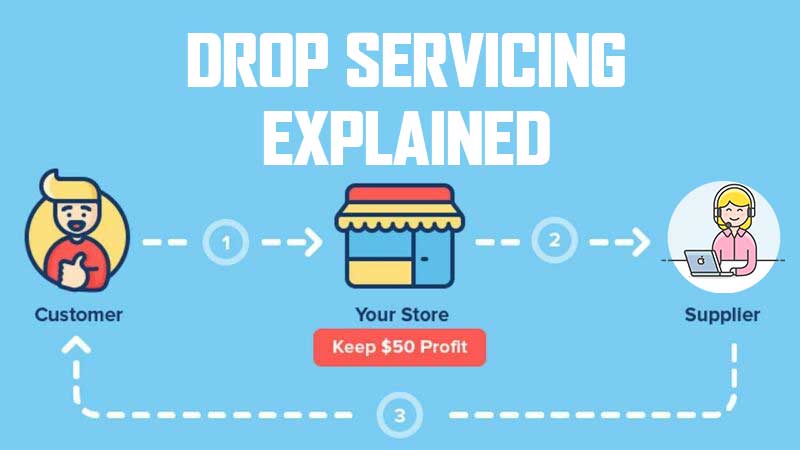In the ever-evolving business environment of today, entrepreneurs are presented with innovative models that open up fresh pathways to success. Early retirement is a consideration as well, and among these models, drop servicing emerges as a promising venture that harnesses the potential of outsourcing to provide valuable services to clients. This in-depth guide delves into the complexities of drop servicing, shedding light on its definition, operational mechanics, benefits, potential business ideas, startup process, legality, profitability, and initial costs.
Introduction to Drop Servicing
Drop servicing represents a modern approach to service delivery, where entrepreneurs act as intermediaries between clients seeking specific services and skilled freelancers or agencies capable of fulfilling those needs. Unlike traditional service providers, drop servicers focus on managing projects and client relationships, outsourcing the execution to specialized professionals while maintaining control over the overall process.
How to Drop Servicing Works
At its core, drop servicing entails a strategic sequence of steps aimed at delivering high-quality services to clients:
- Identification of Services: Entrepreneurs identify in-demand services with lucrative potential.
- Sourcing Talent: Skilled freelancers or agencies are sourced to execute the required tasks.
- Client Acquisition: Marketing efforts are employed to attract clients seeking the offered services.
- Pricing Strategy: Pricing structures are established, balancing costs, profit margins, and market demand.
- Project Coordination: Entrepreneurs manage project workflows, ensuring seamless communication between clients and service providers.
- Final Delivery: Completed projects are delivered to clients, and feedback is solicited to ensure satisfaction.
Throughout this process, entrepreneurs play a pivotal role in orchestrating operations, maintaining quality standards, and fostering positive client relationships.
Benefits of Drop Servicing
The appeal of drop servicing lies in its array of advantages, including:
- Low Startup Costs: Compared to traditional businesses, drop servicing ventures require a minimal initial investment, primarily focusing on website development, marketing, and operational expenses.
- Consistent Client Base: The demand for digital services remains robust, providing drop servicers with a steady stream of clients seeking solutions to their diverse needs.
- Work Anywhere Flexibility: With the freedom to operate remotely, entrepreneurs can manage their drop servicing businesses from anywhere with an internet connection, offering unparalleled flexibility.
- No Expert Skills Required: Entrepreneurs need not possess specialized skills in the services they offer; instead, they focus on business management, client acquisition, and project coordination.
- Smooth Operations: Unlike businesses dealing with physical goods, drop servicing ventures circumvent logistical complexities, enabling streamlined operations and efficient service delivery.
Difference between Dropshipping and Drop Servicing
While dropshipping and drop servicing share similarities in their reliance on outsourcing, they diverge in their focus on physical products and digital services, respectively. Dropshipping involves selling physical products without inventory management, while drop servicing revolves around offering digital services without direct involvement in execution.
Five Drop Service Business Ideas
- Video Production and Editing: Cater to the growing demand for video content by offering comprehensive video production and editing services to businesses and content creators.
- Local Search Engine Optimization: Assist local businesses in improving their online visibility and attracting nearby customers through tailored SEO strategies.
- WordPress Customization: Provide WordPress website customization services, catering to the needs of businesses seeking unique and user-friendly web solutions.
- Podcast Production: Capitalize on the rising popularity of podcasts by offering end-to-end production services, including planning, recording, editing, and distribution.
- LinkedIn Lead Generation: Help businesses generate high-quality leads on LinkedIn by leveraging specialized expertise in profile optimization, content creation, and networking strategies.
How to Start a Drop Servicing Business
- Choose Your Niche: Identify a niche market with high demand and profit potential, considering factors such as personal expertise, market trends, and client needs.
- Find and Train Your Team: Build a team of skilled freelancers or agencies capable of delivering exceptional services, ensuring alignment with your business objectives and quality standards.
- Build Your Brand: Forge a robust brand identity by crafting captivating visuals, messaging, and online presence, setting your drop servicing business apart in the competitive market landscape.
- Attract Customers: Implement targeted marketing strategies to reach potential clients, leveraging channels such as social media, content marketing, email campaigns, and referral programs.
- Make Your First Sale: Secure your inaugural clients through effective sales tactics, delivering exceptional service to build credibility and foster long-term relationships.
Legality of Drop Servicing
While drop servicing is a legal business activity, entrepreneurs must navigate regulatory requirements and taxation policies to ensure compliance. Drafting comprehensive terms and conditions, understanding tax obligations, and obtaining appropriate insurance coverage are essential steps to mitigate legal risks and safeguard business operations.
Profitability of Drop Servicing
The profitability of drop servicing hinges on offering high-demand services, implementing competitive pricing strategies, and delivering exceptional value to clients. By charging a markup on outsourced services and optimizing operational efficiencies, entrepreneurs can generate sustainable profits and expand their businesses over time.
Costs of Starting a Drop Servicing Business
The startup costs for initiating a drop servicing venture are generally modest, covering expenditures like website development, freelancer payments, marketing initiatives, and operational expenses. Entrepreneurs can minimize costs by leveraging cost-effective tools, outsourcing non-core functions, and strategically allocating resources to maximize returns on investment.
Conclusion
In conclusion, drop servicing offers entrepreneurs a viable pathway to success in the digital age, enabling them to capitalize on the burgeoning demand for specialized services. By comprehending the intricacies of the drop servicing model, recognizing lucrative business opportunities, and implementing strategic initiatives, entrepreneurs can establish thriving enterprises that provide value to clients and foster sustainable growth in the competitive marketplace.





